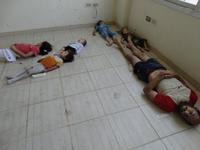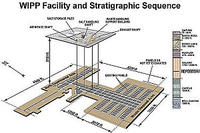-
Pocket-sized anthrax detector aids global agriculture
Bacillus anthracis, the bacteria that causes anthrax, is commonly found in soils all over the world and can cause serious, and often fatal, illness in both humans and animals. The bacteria can survive in harsh conditions for decades. In humans, exposure to B. anthracis may occur through skin contact, inhalation of spores or eating contaminated meat. A credit-card-sized anthrax detection cartridge developed at Sandia National Laboratories and recently licensed to a small business makes testing safer, easier, faster, and cheaper.
-
-
Floating nuclear plants could ride out tsunamis
When an earthquake and tsunami struck the Fukushima Daiichi nuclear plant complex in 2011, neither the quake nor the inundation caused the ensuing contamination. Rather, it was the aftereffects — specifically, the lack of cooling for the reactor cores, due to a shutdown of all power at the station — that caused most of the harm. A new design for nuclear plants built on floating platforms, modeled after those used for offshore oil drilling, could help avoid such consequences in the future. Such floating plants would be designed to be automatically cooled by the surrounding seawater in a worst-case scenario, which would indefinitely prevent any melting of fuel rods, or escape of radioactive material.
-
-
Identifying the most likely non-state chem-bio threats
New research finds that Jihadists pose the most likely chem-bio threat, but other actors also featured as top threats. Jihadist actors occupied seven of the top 10 spots in a qualitative analysis; nine of the top 10 in a quantitative analysis; and half of the top 10 in an elicitation analysis.
-
-
2014 edition of updated first responder biodetection technology guide available
A 2014 update to a detailed product guide listing biodetection technologies and sampling products is now available. The updated digest, Biodetection Technologies for First Responders: 2014, provides a comprehensive compilation of commercially available detection devices and products published to help first responders when purchasing equipment and supplies needed to rapidly assess biological threats.
-
-
Lt. Gen. Frank Klotz (Ret) confirmed as DoE undersecretary for nuclear security, NNSA administrator
Lieutenant General Frank G. Klotz, United States Air Force (Ret.), was confirmed by the Senate on Tuesday, 8 April 2014, as the Department of Energy’s undersecretary for nuclear security and administrator for the National Nuclear Security Administration (NNSA).
-
-
Debate over closing NY’s Indian Point nuclear power plant intensifies
Indian Pointnuclear power plant, just thirty miles from New York City, has presented a conundrum for environmentalists who advocate clean-air initiatives, caps on carbon emissions, and increasing investment in non-polluting renewable energy sources — but at the same time argue that nuclear power poses a safety hazard to the surrounding area and demand that Indian Point cease operations. Closing the plant would require a long-term energy strategy to replace the 2,000 megawatts the plant currently produces.
-
-
Israel: Assad used chemical weapons on 27 March in a Damascus neighborhood

President Bashar Assad’s military used chemical weapons two weeks ago in a neighborhood east of Damascus against opposition forces, a senior Israeli defense official said yesterday (Monday). Syrian rebels reported of two instances in which Assad’s forces used chemical weapons recently, both about two weeks ago and both in Damascus neighborhoods, and the Israeli confirmation was the first information provided by outside intelligence sources to back up the rebels’ claims.
-
-
Chemical plant security measure moves forward in the House
The House Homeland Security Committee and the House Energy and Commerce Committee are making progress on legislation meant to extend DHS’s Chemical Facility Anti-Terrorism Standardsprogram, which helps secure commercial chemical plants from terrorist attacks. Several attempts by the House Homeland Security Committee to extend the program have failed due to disagreements with the House Energy and Commerce Committee, which also oversees the matter.
-
-
New consortium dedicated to developing nuclear arms control verification technologies
A consortium of thirteen universities and eight national laboratories, led by the University of Michigan and including the Los Alamos National Laboratory as a partner, has been awarded a $25 million grant by the NNSA. The consortium is dedicated to the research and development (R&D) of nuclear arms control verification technologies, including nuclear safeguards effectiveness.
-
-
Cutting edge, animatronic mannequin to test CB protective suits, equipment
The U.K. Defense Science and Technology Laboratory (DSTL) has taken delivery of a new robotic mannequin which will be used to test chemical and biological (CB) protective suits and equipment for the U.K.’s Armed Forces. The “Porton Man” uses state of the art technology and is able to walk, march, run, sit, kneel and even lift its arms as if to sight a weapon just like an infantry soldier.
-
-
Alternative strategy for uranium processing at Oak Ridge
A group of twenty-five experts referred to as the Red Team, assigned to review alternatives to the Uranium Processing Facility (UPF) at Oak Ridge National Laboratory, have reached a “strong consensus” on what could be an alternative strategy, but will spend the next two weeks polishing their work before presenting it to National Nuclear Security Administration (NNSA). Red Team was instructed to design a way to move uranium processing from Building 9212, Y-12’s Second World War-era center for processing highly enriched uranium, by 2025 and at under $6.5 billion.
-
-
New group formed to monitor Savannah River Site, nuclear waste issues in SE U.S.
Savannah River Site Watch (SRS Watch), a new public-interest watchdog group, was launched last week in what it said was a response to the need for increased monitoring of the nuclear projects carried out by the U.S. Department of Energy (DOE). The group says it has been formed to focus on an array of nuclear projects now underway at Savannah River Site (SRS), the sprawling 310-square mile complex located near Aiken, South Carolina.
-
-
Los Alamos National Lab resumes transuranic waste shipments

The waste was received at Waste Control Specialists in Andrews, Texas, where it will be temporarily staged until it can be shipped to the Waste Isolation Pilot Plant (WIPP) near Carlsbad, New Mexico for final disposal. WIPP has been closed since mid-February as a result of radiation leaks in underground storage tunnels. The shipments keep LANL on track to complete 3,706 Campaign on schedule. The campaign aims to remove 3,706 cubic meters of nuclear waste from LANL by 30 June 2014.
-
-
New center will work to improve methods to detect, prevent the spread of nuclear weapons
The National Nuclear Security Administration (NNSA) has awarded the University of Michigan $25 million to establish the Center for Verification Technology. A team from thirteen universities will work with eight national labs to analyze nuclear nonproliferation efforts, improve technologies for monitoring weapons-grade materials and detecting secret weapon tests, and train the next generation of nonproliferation experts.
-
-
Possibility of “dirty bombs” a major terrorism threat
The International Atomic Energy Agency (IAEA) has warned that there were 140 cases of missing or unauthorized nuclear and radioactive material in 2013 — a pressing reminder that the possibility of possession of nuclear materials by terrorist organizations is both real and current.
-
More headlines
The long view
Keeping the Lights on with Nuclear Waste: Radiochemistry Transforms Nuclear Waste into Strategic Materials
By John Domol
How UNLV radiochemistry is pioneering the future of energy in the Southwest by salvaging strategic materials from nuclear dumps –and making it safe.
Model Predicts Long-Term Effects of Nuclear Waste on Underground Disposal Systems
By Zach Winn
The simulations matched results from an underground lab experiment in Switzerland, suggesting modeling could be used to validate the safety of nuclear disposal sites.
